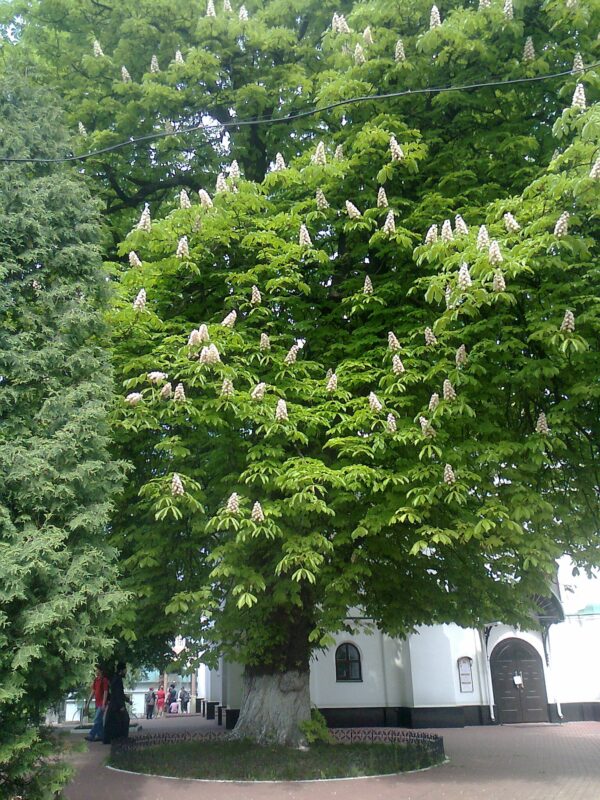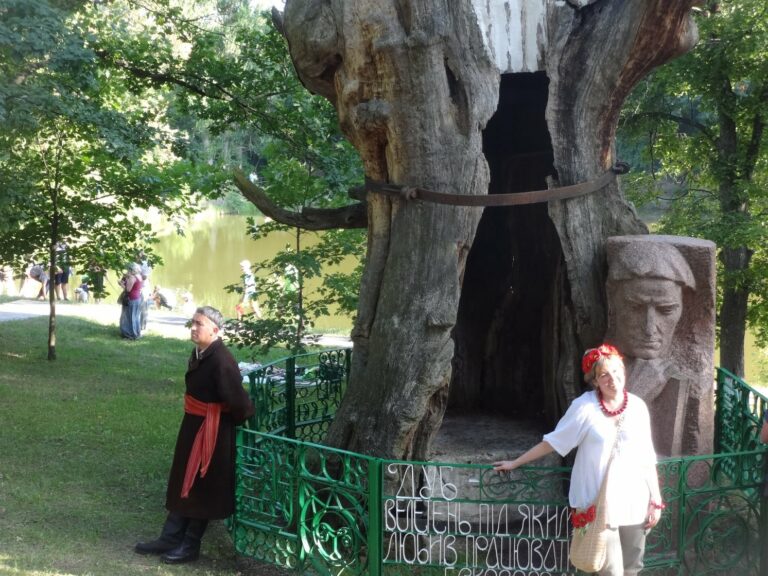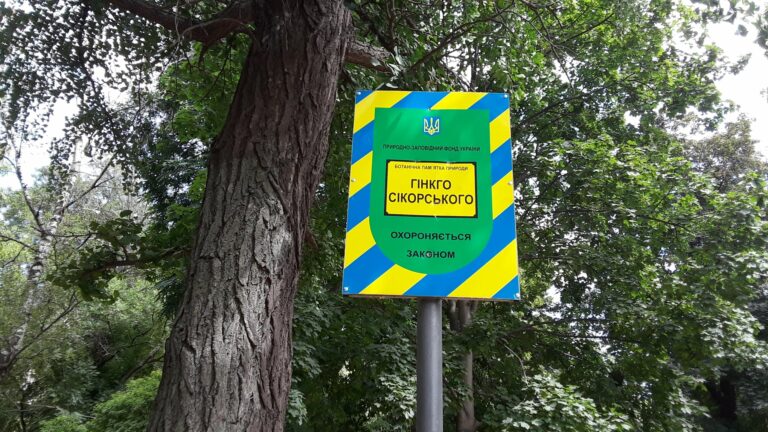… He slightly trampled the ground around the trunk of the tree he had just planted, nodded contentedly. Before long, this chestnut will turn green, put forth leaves, it will be reminiscent of native Wallachia. But it was time to take on other things. The Archimandrite of the Kyiv-Pechersk Lavra has a lot of them. Petro Mohyla laid aside the spade and took the path away from the Kytayivsky ponds…
Unfortunately, there is no documentary evidence that the oldest chestnut tree in Kyiv was planted by Petro Mohyla. There are only narrations. And the tree itself. Majestic and especially lush when it blooms in May. According to dendrologists, it may be over 350 years old.
This chestnut (scientific name – Aésculus hippocástanum, not to be confused with sweet chestnut, they belong to different families) grows near the Trinity Church in Kyiv, in Golosiyivsky forest. It is considered to be the oldest representative of the species in Ukraine.
Such trees that have certain age or are associated with the names of famous persons or historical events, are interesting not only as botanical phenomena. They are living monuments, living witnesses of those events. It is worth imagining that two centuries ago Taras Shevchenko took a rest near that pine tree, and a hundred years earlier the haidamaki consecrated their knives under this oak – and you grow cold with emotions. Such trees deserve special treatment and special protection.
Experts recommend giving these long-lived trees the status of a natural monument and take good care of them: surround them with a protective fence, treat holes, support frame branches, etc.
Enthusiasts, in particular, the public organization Kyiv Ecological and Cultural Center, are mainly engaged in the search, care and treatment of such trees. The collection of environmental activists includes more than half a thousand secular and memorial trees. Indifferent people from all over the country helped to find information.
LIST OF THE OLDEST TREES OF UKRAINE
- the oldest tree in Ukraine – olive, 2000 years. Grows in the Nikitsky Botanical Garden, AR of Crimea. Trunk girth – 8.8 m;
- the oldest juniper – 1400 years. Grows in the Batiliman stow near Cape Aya, AR of Crimea. Trunk girth – 3.45 m;
- the oldest yew – yew Zakharzhevsky, 1300 years. Grows on Ai-Petri in the Yalta Mountain and Forest Reserve, AR of Crimea. Trunk girth – 3.76 m;
- the oldest strawberry tree – Yena strawberry tree, 1300 years. Grows on Mount Ai-Nikola, AR of Crimea. Trunk girth – 5.8 m;
- the oldest pistachio – age about 1500-1700 years. Grows in the Nikitsky Botanical Garden, AR of Crimea. Trunk girth – 10.32 m;
- the oldest oak – Champion Oak, age 1300 years. It grows in the village of Stuzhytsia, Uzhhorod (before the administrative reform – Velykoberezniansky) district of Zakarpattia region. Trunk girth – 9.60 m;
- the oldest linden, age – more than 800 years. It grows in the village of Pidhirtsi, Zolochiv (before the administrative reform – Brody) district of Lviv region. Trunk girth – 7.4 m;
- the oldest plane tree, age – about 200 years. Grows in the Nikitsky Botanical Garden, AR of Crimea. Trunk girth – 6.70 m;
- the oldest hornbeam, age – 300 years. It grows in Maherivsky forestry of Yavoriv district in Lviv region. Double trunk girth – 8.79 m;
- the oldest maple-sycamore, age – about 300 years. Grows in the village of Tukholka of Stryj (formerly Skole) district in Lviv region. Trunk girth – 5.1 m;
- the oldest poplar, trunk circumference – 9.06 m. Height – 27 m. Age 400 years. Grows near the village of Uhiltsi of Rivne (formerly Goscha) district in Rivne region;
- the oldest chestnut is the chestnut of Petro Mohyla, age – 350 years. Grows in Kyiv. Trunk girth – 4.15 m;

- the oldest ash tree, age – about 400 years. Grows in Uzhgorod. Trunk girth – 4.9 m;
- the oldest pear, age – 300 years. Grows in Kryvyi Rih, Dnipropetrovsk region. Trunk girth – 3.89 m;
- the oldest mulberry, age – about 300 years. Grows in the Khan’s Palace, Bakhchisarai, AR of Crimea. Trunk girth – 6 m;
- the oldest walnut, age – almost 500 years. Grows in the village of Verkhorichchya of Bakhchisaray district, AR of Crimea. Trunk girth – 5.75 m;
- the oldest pine, age – over 500 years. Grows in the village of Sylne, Kovel (formerly – Luboml) district in Volyn region. Trunk girth – 6.13 m. Height 25 m;
- the oldest aspen, age – about 300 years. Grows in the Myrhorod district of Poltava region. Trunk girth – 7.4 m;
- the oldest apple tree, age – 200-300 years. Grows in Krolevets, Sumy region. It has many trunks.
HOW TO DETERMINE THE AGE OF A TREE
Enthusiasts continue to maintain a cadaster of memorial and age-old trees in Ukraine. Specimens aged 1000 years and older have the greatest value. In Ukraine, oaks, strawberries, pistachios, junipers, yews, olives, lindens and nuts live up to this age. Their age is determined by the girth of the trunk.
The girth of such oaks is more than 7.8 m; strawberry trees – from 5 m; pistachios – from 5 m; yews – from 2.5 m; junipers – from 2.5 m; olive trees – from 5 m; lindens – from 9 m. The girth of strawberry trees, pistachios and olives is measured at ground level, for the rest of trees – at a height of 1.3 m.
Trees aged 600-700 years are also an interesting find. Such oaks have a trunk girth of about 6 m and more, lindens, walnuts – 5 m. Pines, ashes, chestnuts, beech trees with a trunk girth of 5 m and more are also worth noting. They have reached their age limit – 400-500 years.

And even the younger trees, which have survived at least a few human generations, are already interesting and worthy of special protection. You can determine the approximate age of the tree by multiplying the girth by a certain factor.
It equals 2.5 for olive tree; 2.5-4.5 for juniper (depending on growing conditions); 1 for walnut; 0.4 for mulberry; 0.3 for plane tree; 0.7–1.5 for pines; 1 for oak; 2-4 for strawberry tree; 2.5–4.5 for yew; 1.1 for linden; 1.5 for hornbeam; 0.5 for horse chestnut.
Note that oak tree after 600-700 years (with a girth of 6 m or more) continues to grow more slowly. During 100 years, it adds not 100 cm, as in youth, but 30-40 cm if it grows in the woods, and 60-80 cm if growing on a sunny lawn.
Elm, ash, pine, beech, white acacia can reach 150-200 years, with a girth of more than 3 m at the level of 1.3 m from the ground. Willow and poplar live up to 150 years with a trunk girth of 5-6 m, and plane tree at this age has a girth of 6 m.
This method is not very accurate, but is valuable because it is non-traumatic. Foresters are usually use a hole borer to determine the age of trees. They drill a thin column of wood from the trunk. Then count the annual rings on it.
TREE TREATMENT AND CARE FOR THEM
Care and treatment can significantly extend the life of trees. Here’s what you need to pay attention and how to deal with problems.
Hollows. They must be cleaned with a scraper to healthy wood, then disinfected with a 5% solution of copper sulfate (or 0.5% manganese solution, or 10% carbolic acid) and dried, and then covered with a mixture of ceresite and gypsum in a ratio of 3: 1. If the hollow is large, add bricks to the mortar. It is best to seal hollows in the summer.
Fresh superficial wounds on the trunk. It is necessary to carefully align the edges with a sharp knife, and then cover with a thick layer of dense oil paint or garden carbolic acid.
Branches. Under no circumstances should the branches of old trees be pruned. This causes stress and opens the door to fungus and rot. Therefore, heavy large old branches that grow low should be supported, and those that are high, should be tied with nylon ropes. If the tree bends (it is typical, for example, for old lindens), it is needed to support the trunk.
Cracks in the trunk. Cracks are usually formed by frost or lightning. The treatment procedure for wide cracks is the same as for hollows. Narrow cracks shall be disinfected with the same solution as the hollow, and then greased with thick oil paint or tree-wound paint. Sometimes it is necessary to fasten the trunk with an iron hoop.
Lightning. Old thick ridged oaks are especially attractive to lightning. To protect them, lightning rods are used, which are installed either on top of the tree, if it is high, or on a pole in its vicinity. if the tree is low. All old oaks aged 900–1000 years, with a girth of 7 meters and more, due to their special value, must be equipped with lightning rods.
Soil depletion. Old trees need to be fed. The soil should be carefully loosened (no deeper than 20-30 cm so as not to expose or damage the roots) for 15 m around the trunk. Then add and heel in manure diluted in water in a ratio of 1: 6. You can use compost. It shall be dispersed on the surface or put in shallow grooves that diverge radially from the trunk.
Trampling. All old trees should be fenced. It is best to block people’s access to them altogether. And those that grow near roads should be protected with large stones to avoid being damaged by cars.
CONTINUE THE TRADITION
Modern fans of trees continue the work of many patriots and nature lovers, who at different times made efforts to preserve the green giants. Professor of the Department of Botany of Kyiv State University Oleksiy L. Lypa did a lot for the inventory and protection of secular and ancient trees. Together with zoologist Anatoliy Fedorenko he prepared a register-directory “Nature Reserves and Monuments” which was published in 1969. Due to this, at the beginning of 1975 in Ukraine there were already 616 old trees under protection.

Today, more than 2,600 secular, ancient, memorial and unique trees are under protection in Ukraine. Most of them grow in Kyiv (almost 260), then, in Lviv and Ternopil regions, where 200 trees are protected, and in Vinnytsia, Chernihiv, Khmelnytsky and Cherkasy regions with about 160 trees in each of them.
If you find an interesting tree, let us know, and we will share the information with conservationists-practitioners.
Oleg LYSTOPAD
Svit newspaper, № 41 – 44, November 2021
